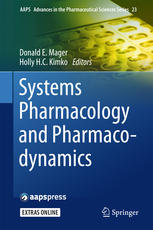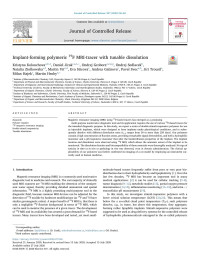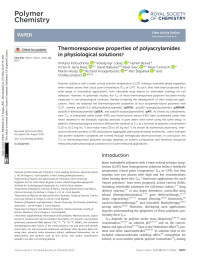
Pharmacokinetics of Intramuscularly Administered Thermoresponsive Polymers
Ondřej Groborz, Kristýna Kolouchová, Tomáš Slanina, Sandra Van Vlierberghe, Richard Hoogenboom, Martin Hrubý, et alAqueous solutions of some polymers exhibit a lower critical solution temperature (LCST); that is, they form phase-separated aggregates when heated above a threshold temperature. Such polymers found many promising (bio)medical applications, including in situ thermogelling with controlled drug release, polymer-supported radiotherapy (brachytherapy), immunotherapy, and wound dressing, among others. Yet, despite the extensive research on medicinal applications of thermoresponsive polymers, their biodistribution and fate after administration remained unknown. Thus, herein, they studied the pharmacokinetics of four different thermoresponsive polyacrylamides after intramuscular administration in mice. In vivo, these thermoresponsive polymers formed depots that subsequently dissolved with a two-phase kinetics (depot maturation, slow redissolution) with half-lives 2 weeks to 5 months, as depot vitrification prolonged their half-lives. Additionally, the decrease of TCP of a polymer solution increased the density of the intramuscular depot. Moreover, they detected secondary polymer depots in the kidneys and liver; these secondary depots also followed two-phase kinetics (depot maturation and slow dissolution), with half-lives 8 to 38 days (kidneys) and 15 to 22 days (liver). Overall, these findings may be used to tailor the properties of thermoresponsive polymers to meet the demands of their medicinal applications. Their methods may become a benchmark for future studies of polymer biodistribution.
Keywords: LCST; biodistribution; poly(2,2-difluoroethyl)acrylamide; poly(N,N-diethylacrylamide); poly(N-acryloylpyrolidine); poly(N-isopropylacrylamide); polyacrylamide; rational polymer design.
 Amazon
Amazon  Barnes & Noble
Barnes & Noble  Bookshop.org
Bookshop.org  Convertissez des fichiers
Convertissez des fichiers Plus de résultats de recherche
Plus de résultats de recherche Autres avantages
Autres avantages 








